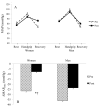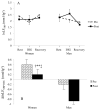Exercise training improves hemodynamic recovery to isometric exercise in obese men with type 2 diabetes but not in obese women
- PMID: 22902004
- PMCID: PMC3504623
- DOI: 10.1016/j.metabol.2012.07.014
Exercise training improves hemodynamic recovery to isometric exercise in obese men with type 2 diabetes but not in obese women
Abstract
Objectives: Women with type 2 diabetes (T2D) show greater rates of mortality due to ischemic heart disease than men with T2D. We aimed to examine cardiovascular and autonomic function responses to isometric handgrip (IHG) exercise between men and women with T2D, before and after an exercise training program.
Materials/methods: Hemodynamic responses were measured in 22 men and women with T2D during and following a 3-min IHG test, and before and after 16 wks of aerobic exercise training.
Results: Women had a smaller decrease in mean arterial pressure (MAP) and systolic blood pressure (BP) during recovery from IHG (ΔMAP(REC)) than men pre- and post-training (P<0.05). Men showed a greater reduction in diastolic BP during recovery from IHG (P<0.05), and exercise training improved this response in men but not in women (men, pre-training: -13.9±1.8, post-training: -20.5±5.3 mmHg vs. women, pre-training: -10.7±1.7, post-training: -4.1±4.9 mmHg; P<0.05). Men had a greater reduction in sympathetic modulation of vasomotor tone (P<0.05), as estimated by blood pressure variability, following IHG. This response was accentuated after training, while this training effect was not seen in women. Post-training ΔMAP(REC) was correlated with recovery of low frequency component of the BP spectrum (ΔLF(SBPrec), r=0.52, P<0.05).
Conclusions: Differences in BP recovery immediately following IHG may be attributed to gender differences in cardiovascular autonomic modulation. An improvement in these responses occurs following aerobic exercise training in obese men, but not in obese women with T2D which reflects a better adaptive autonomic response to exercise training.
Copyright © 2012 Elsevier Inc. All rights reserved.
Figures


Similar articles
-
Sex Differences in Cardiac Baroreflex Sensitivity after Isometric Handgrip Exercise.Med Sci Sports Exerc. 2018 Apr;50(4):770-777. doi: 10.1249/MSS.0000000000001487. Med Sci Sports Exerc. 2018. PMID: 29135601 Clinical Trial.
-
Isometric handgrip training lowers blood pressure and increases heart rate complexity in medicated hypertensive patients.Scand J Med Sci Sports. 2013 Oct;23(5):620-6. doi: 10.1111/j.1600-0838.2011.01435.x. Epub 2012 Jan 20. Scand J Med Sci Sports. 2013. PMID: 22260503
-
Endurance training improves post-exercise cardiac autonomic modulation in obese women with and without type 2 diabetes.Eur J Appl Physiol. 2007 Jul;100(4):437-44. doi: 10.1007/s00421-007-0446-3. Epub 2007 Apr 4. Eur J Appl Physiol. 2007. PMID: 17406886 Clinical Trial.
-
Impaired postexercise cardiovascular autonomic modulation in middle-aged women with type 2 diabetes.Eur J Cardiovasc Prev Rehabil. 2007 Apr;14(2):237-43. doi: 10.1097/HJR.0b013e32801da10d. Eur J Cardiovasc Prev Rehabil. 2007. PMID: 17446802
-
The Effects of Aerobic Exercise Training on Testosterone Concentration in Individuals Who are Obese or Have Type 2 Diabetes: A Systematic Review and Meta-Analysis.Sports Med Open. 2024 Oct 29;10(1):117. doi: 10.1186/s40798-024-00781-x. Sports Med Open. 2024. PMID: 39467940 Free PMC article.
Cited by
-
Sex Differences in the Glycemic Response to Structured Exercise Interventions in Adults with Type II Diabetes Mellitus: A Systematic Review.Int J Exerc Sci. 2022 Jul 1;15(3):948-961. doi: 10.70252/MLOQ6237. eCollection 2022. Int J Exerc Sci. 2022. PMID: 36158228 Free PMC article. Review.
-
Development of a recumbent isometric yoga program for patients with severe chronic fatigue syndrome/myalgic encephalomyelitis: A pilot study to assess feasibility and efficacy.Biopsychosoc Med. 2017 Mar 3;11:5. doi: 10.1186/s13030-017-0090-z. eCollection 2017. Biopsychosoc Med. 2017. PMID: 28270860 Free PMC article.
-
Inflammatory markers and blood glucose are higher after morning vs afternoon exercise in type 2 diabetes.Diabetologia. 2025 Sep;68(9):2023-2035. doi: 10.1007/s00125-025-06477-5. Epub 2025 Jun 28. Diabetologia. 2025. PMID: 40580209 Free PMC article.
-
The Obesity-Impulsivity Axis: Potential Metabolic Interventions in Chronic Psychiatric Patients.Front Psychiatry. 2017 Feb 13;8:20. doi: 10.3389/fpsyt.2017.00020. eCollection 2017. Front Psychiatry. 2017. PMID: 28243210 Free PMC article. Review.
References
-
- Grassi G, Seravalle G, Cattaneo BM, Bolla GB, Lanfranchi A, Colombo M, et al. Sympathetic activation in obese normotensive subjects. Hypertension. 1995;25(4 Pt 1):560–3. Epub 1995/04/01. - PubMed
-
- Grassi G, Seravalle G, Colombo M, Bolla G, Cattaneo BM, Cavagnini F, et al. Body weight reduction, sympathetic nerve traffic, and arterial baroreflex in obese normotensive humans. Circulation. 1998;97(20):2037–42. - PubMed
-
- Vaz M, Jennings G, Turner A, Cox H, Lambert G, Esler M. Regional sympathetic nervous activity and oxygen consumption in obese normotensive human subjects. Circulation. 1997;96(10):3423–9. Epub 1997/12/13. - PubMed
-
- Dipla K, Zafeiridis A, Koidou I, Geladas N, Vrabas IS. Altered hemodynamic regulation and reflex control during exercise and recovery in obese boys. Am J Physiol Heart Circ Physiol. 2010;299(6):H2090–6. Epub 2010/10/19. - PubMed

